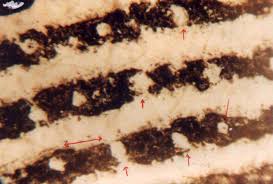Poroscopy also known as ‘Locard’s method’ is a method of personal identification through the comparison of impression of sweat pores.

The method was discovered and developed by Edmond Locard in 1912. Locard observed that like the ridge characteristics, the pores are also permanent, immutable and individual, and these are useful to establish the identity or otherwise of individuals when available ridges do not provide sufficient ridge characteristics.
Methods:
The present study is based on inked finger prints and palm prints of one hundred individuals. The plain and rolled inked finger prints of each individual were obtained on white plain paper sheet according to the standard method described by Henry. Each individual was requested to place his palm on surfaces like paper, glazed tiles, glass sheet, painted doors and glazed metal surfaces of fridge, oven etc. for latent prints.

These latent prints were developed by various standard methods as powder method, iodine fuming, ninhydrin and silver nitrate method. The following features of pores were studied under a simple microscope with 50x magnification.
1. Number of Pores
Under 50x magnification, average length of a ridge under view was found to be about 0.5 cm. Pores were counted on the ridges at random and average number of pores per centimeter of ridge was calculated.
2. Distance between Pores (Interspacing)
The spacing between the pores was calculated on the basis of number of pores in per unit area and their configuration, they were classified as:
a) Pores with close interspacing : Where pores were lying very close to each other and more than twelve pores were present on 1 cm. ridge length.
b) Pores in groups with close interspacing : The pores lying in the groups of two or more than two number of pores on 1 cm. Ridge length were classified as pores in groups.
c) Pores with distant interspacing: The number of pores present on one centimeter ridge length ranged from 8 to 11 and the space between the pores was comparatively more.
d) Pores with chain like formation : In this type of configuration, the pores were connected with each other making a chain like appearance and there was no interspacing present between the two pores.
3. Size of Pores
Size of the pores was determined by comparing the pores with the largest pore in the print and divided as:
{a} minute
{b} medium
{c} large
4. Shape of Pores
Pores on the same ridge was found to be of different shape as following:
- Rounded
- Rhomboid
- Elliptical Square
- Rectangular.
In each area, the frequency of all these type of pores was determined by counting the number of pores of a particular shape.
5. Position of the Pores on the ridge
Position of the pores on a ridge was determined by noting whether the pore was situated in the center of the ridge or on the periphery of the ridge. If lying on the periphery, the pore could either be an open type, i.e. with an open mouth towards furrow or just lying on the periphery with closed, well defined boundary, i.e. closed type.
🔥609 Views





